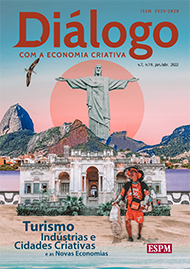The experience of UNESCO Creative Cities in the context of COVID-19: a case study of Brazilian cities
DOI:
https://doi.org/10.22398/2525-2828.719118-136Resumo
This paper aims to analyze Curitiba and Florianopólis, the two oldest UNESCO creative cities in Brazil, in a comparative approach. The propose is to identify in which extent the UNESCO labelling process has contributed to promote the chosen modality and related sectors. Moreover, given the current global pandemic, this study also draws a portrait of before and after COVID-19, especially when it comes to the tourism enterprise. For that, we use secondary data as well as primary data to deal with both cities case studies. Our secondary sources tackles labor market data and tourism flow contextualized to the two territories, exploring the Network's potential, achievements and challenges after the label granting added up the pandemic setting.
Referências
BOAL, Iván; HERRERO, Luis César. Where are the artists? Analysing economies of agglomeration in Castile and León, Spain. Papers in Regional Science, v. 97, n. 4, p. 995-1016, 2018.
FLORIDA, R., MELLANDER, C. AND STOLARICK, K. Inside the black box of regional development—human capital, the creative class and tolerance, Journal of Economic Geography, 8, pp. 615–649, 2008.
FIGUEIREDO, J L; JESUS, D; ROBAINA, D; COURI, C. The development potential index of creative economy for Brazilian federal state capitals, Creative Industries Journal,12:2, 185-203, 2019
GIRARD, L F; BAYCAN, T; NIJKAMP, P. Sustainable City and Creativity: promoting creative urban initiatives. 5. ed. England: Ashgate Publishing, Ltd., 2011. 476 p.
JENSEN, O. B. Culture stories: Understanding cultural urban branding. Planning Theory, v. 6, n. 3, p. 211-236, 2007.
Kim, S.; Bramwell, B. Boundaries and boundary crossing in tourism: A study of policy work for tourism and urban regeneration, Tourism Management, 75, 78–89, 2019.
LANDRY, C. The creative city: the story of a concept. In: REIS, A. C. F. & KAGEYAMA, P. (Orgs), Creative city perspectives. Available in: http://www.garimpodesolucoes.com.br, 2009
LANDRY, C. Maximizing the Potential of the UNESCO Creative City Network. 2018. Availabe in: http://charleslandry.com/panel/wp-content/uploads/downloads/2017/07/Maximizing-the-Potential-of-the-UNESCO-Creative-Cities-Network.pdf, 2018.
MACHADO, A. F.; DINIZ, S. C. ; NASCIMENTO, J. ; MAIA, R. . Desenvolvimento urbano, Economia Criativa e produção solidária em uma metrópole brasileira. In: Claudia Leitão; Ana Flávia Machado. (Org.). Por um Brasil Criativo: Significados, Desafios e Perspectivas da Economia Criativa Brasileira. 1ed.Belo Horizonte: Código, v. 1, p. 239-268, 2016.
MIGUEL, Boal-San et al. Reliability of creative composite indicators with territorial specification in the EU. Sustainability, v. 12, n. 8, p. 3070, 2020.
GUIMARAES, A. D.; RIBEIRO, S.B.; MACHADO, A.F. Repercussion of the label in a comparative analysis of indicators. Creative Industries Journal, v. 14, p. 1-17, 2020.
RICHARDS, G. Cultural tourism: A review of recent research and trends. Journal of Hospitality and Tourism Management, 36, 12-21, 2018.
Richards, G; Wilson, J. Developing creativity in tourist experiences: A solution to the serial reproduction of culture?, Tourism Management, 27, 1209–1223, 2006.
ROSI, M. Branding or sharing?: The dialectics of labeling and cooperation in the UNESCO Creative Cities Network. City, Culture and Society, v. 5, n. 2, p. 107-110, 2014.
SASAKI, Masayuki. Creative Industries and Creative City Policy in Japan Em: LAZZERETTI, L. Creative Industries and Innovation in Europe: Concepts, Measures and Comparative Case Studies. Série Regions and Cities, London, 2013.
Sofield, T.; Guia, J.; Specht, J. Organic ‘folkloric’ community driven place-making and tourism, Tourism Management, 61, 1-22, 2017.
UNCTAD; Relatório de economia criativa 2010: economia criativa uma, opção de desenvolvimento. – Brasília : Secretaria da Economia Criativa/Minc ; São Paulo : Itaú Cultural, 2012.
UNESCO; UCCN MEMBERSHIP MONITORING REPORT 2018. Curitiba, Brasil: 2018. Accessed in: <https://en.unesco.org/creative-cities/sites/creative-cities/files/curitiba_report.pdf>. Access in: 23 jan. 2021.
UNESCO. Why Creativity? 2019. Available in: https://en.unesco.org/creative-cities/content/why-creativity-why-cities Accessed in: 23 jan.arch 2021.
UNESCO. Strategic Framework. UNESCO Creative Cities Network (UCCN) Building A Collective Vision For The Future. Available in: https://en.unesco.org/creative-cities/sites/creative-cities/files/strategic-framework_UCCN.pdf Accessed in: 23 jan. 2021.
UNESCO. Creative Cities Network. Available in: https://en.unesco.org/creative-cities/ Accessed in June, 2019
UNESCO. Mission Statement. Available in: https://en.unesco.org/creative-cities/sites/creative-cities/files/Mission_Statement_UNESCO_Creative_Cities_Network_1.pdf Accessed in: 07 jan.2021
UNESCO. Monitoring Guidelines. Available in: https://en.unesco.org/creative-cities/sites/creative-cities/files/Membership%20Monitoring%20Guidelines%202017.pdf
UNESCO. Join the Network. Available in: https://en.unesco.org/creative-cities/content/join-network. Accessed in: 07 jan. 2020
UNESCO. Application Guide. Available in: https://en.unesco.org/creative-cities/sites/creative-cities/files/2019-uccn-call_application-guide_en_1.pdf
UNESCO. UNESCO Creative Cities' response to COVID-19. https://en.unesco.org/covid19/cultureresponsecreative-cities-mobilized-against-COVID-19 Accessed in 07 jan. 2021.
UNITED NATIONS/UNCTAD. Creative Economy: a feasible development option. Creative Economy Report. Genebra, 2010
Warren, G; Dinnie, K. Cultural intermediaries in place branding: Who are they and how do they construct legitimacy for their work and for themselves?, Tourism Management, 66: 302-314, 2018.
Yu, C.; Runsheng, S. The role of Instagram in the UNESCO's creative city of gastronomy: A case study of Macau, Tourism Management, 75, 257–268, 2019.
Downloads
Publicado
Como Citar
Edição
Seção
Licença
Os direitos autorais para artigos publicados nesta revista são do autor, com direitos de primeira publicação para a revista.
Ressaltamos que a responsabilidade dos artigos é de exclusividade do(s) autor(es) e não reflete, necessariamente, a opinião dos Editores ou da ESPM.








